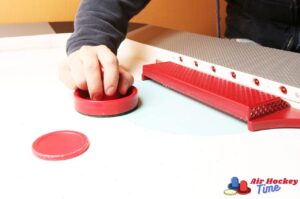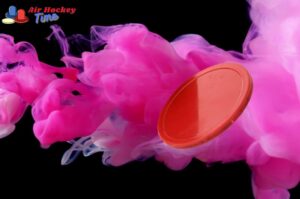Air hockey players engage in fast-paced matches, utilizing skill and precision to outmaneuver their opponents.
However, amidst the excitement and intensity, specific rules govern the game to ensure fair play and maintain its integrity.
One such rule pertains to a technique known as “topping.” In this discussion, we will delve into the concept of topping in air hockey, exploring what it entails and why it is not permitted. Understanding this technique’s restrictions is vital for players seeking to master the game and compete within the established guidelines.
So, let us explore the intricacies of topping and its role in the dynamic world of air hockey.

Topping In Air Hockey – the rule
Topping in air hockey refers to attempting to strike the puck by lifting the mallet and placing it directly on top of it.
However, it is essential to note that topping is not allowed in the game.
Players are not permitted to lift their mallets and place them on the puck at any point, whether before or after a serve.
Instead, players must strike the puck using any mallet part without lifting it off the table surface.
This rule ensures fair play and maintains the integrity of the game, as it prevents players from gaining an unfair advantage by improperly controlling the puck.
By adhering to the rule against topping, players must rely on their skill and timing to strike the puck accurately and effectively, adding challenge and excitement to the air hockey game.
What To Do if You Accidentally Top Your Puck
In air hockey, “topping,” which involves lifting the mallet and placing it directly on top of the puck, is strictly prohibited.
However, it’s important to note that no specific penalty is explicitly assigned for topping in the official rules of air hockey.
In the heat of an intense air hockey match, it’s possible for even experienced players to accidentally top the puck by lifting their mallet and placing it directly on top of it.
If you find yourself in this situation, it’s important to react appropriately.
Firstly, acknowledge the mistake and immediately inform your opponent.
Honesty and sportsmanship are crucial in such instances.
Next, follow the established rules of the game and halt play.
Reset the puck to its previous position and resume the game with a fair serve.
Accidental topping is not intentional, but taking responsibility for the error and rectifying it promptly is essential.
By doing so, you uphold the principles of fair play and maintain the integrity of the game. Remember, air hockey is about winning and displaying respect and sportsmanship toward your opponent.
Tips For Avoiding Topping When Playing Air Hockey
To ensure fair play and adhere to air hockey rules, it’s essential to avoid topping the puck during gameplay.
Here are some tips to help you steer clear of this prohibited action.
First and foremost, maintain awareness of your mallet position at all times.
Be mindful not to lift it excessively or contact the puck from above.
Focus on keeping your mallet parallel to the table surface, enabling you to strike the puck cleanly. Additionally, work on your hand-eye coordination and develop precise control over your movements.
Practice striking the puck with the appropriate force and accuracy, using the flat surface of the mallet while it remains in contact with the table.
Finally, play with a relaxed grip, allowing for fluid movement and minimizing the chances of inadvertently topping the puck.
By incorporating these tips into your gameplay and practicing them regularly, you can refine your technique, maintain fair play, and enjoy a rewarding air hockey experience.
Learn The Value of Knowing the Rules and Practices of Air Hockey When Playing Against Others
Air hockey is a game that is both thrilling and fun.
If you enjoy playing this game, you’ll want to make sure you know all the rules and best practices to become a top player.
Knowing the game inside-out will not only help you play better, but it’ll also give you the confidence to face off against others.
You can make better passes and more accurate shots by keeping up-to-date with the latest rules.
You won’t have to worry about breaking the rules and losing points.
The more prepared you are, the more fun you’ll have, and the more you will reap the many benefits of being a skilled air hockey player.
So, brush up on your skills and get out there to conquer the table!
Frequently asked questions
What are the circles for in air hockey?
The circles on an air hockey table are essential in the game.
Typically located at each end of the table, these circles, also known as goal creases, mark the designated areas where the goals are situated.
They provide a visual reference point for players and spectators, outlining the region where the puck must cross to score a goal.
The circles also play a functional role during gameplay, as they help players determine their shots’ positioning and assist in strategic decision-making.
Additionally, the circles contribute to the aesthetic appeal of the air hockey table, adding visual symmetry and enhancing the overall look of the playing surface.
By understanding the significance of the circles, players can effectively navigate the game, aim for accurate shots, and fully appreciate the design and functionality of the air hockey table.
What is the penalty in air hockey?
In the game of air hockey, penalties are imposed for certain infractions.
Two types of penalties can occur.
Firstly, a foul results in the forfeiture of the puck by the offending player.
When a foul is committed, the opponent gains possession of the puck. Secondly, a technical foul incurs a penalty in the form of a free shot.
In this case, the innocent player is allowed to take a free shot at the unprotected goal of the guilty player.
These penalties ensure that fair play is maintained and provide consequences for rule violations in air hockey.
Understanding the penalties is crucial for players to adhere to the rules, avoid infractions, and compete in a sportsmanlike manner.
In conclusion
Topping in air hockey refers to lifting the mallet and placing it directly on top of the puck, which is strictly prohibited.
This technique violates the rules of the game, giving players an unfair advantage by manipulating the puck improperly.
Topping undermines the integrity of air hockey, which is built on skill, precision, and fair competition.
By understanding the prohibition against topping, players can focus on honing their abilities within the established guidelines, ensuring an exciting and level playing field.
Embracing good sportsmanship and adhering to air hockey rules ensures that the game remains true to its essence—fast-paced, skill-driven, and full of exhilarating moments.








